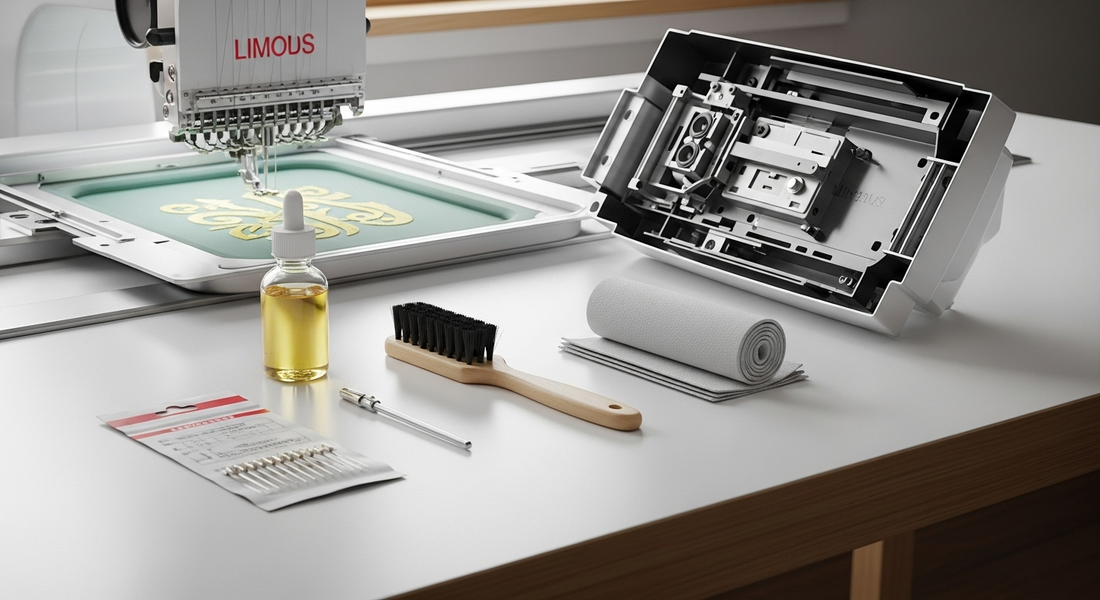
Keeping Your Embroidery Machine Happy: Cleaning, Oiling & Simple Tune-Ups
Share
Let’s face it—your embroidery machine isn’t exactly begging for attention, but give it a little love and it’ll reward you with beautiful, flawless stitching. Neglect it, though, and it might start acting out with missed stitches, frayed thread, or worse… a completely ruined project.
Whether you're stitching as a hobby or running a full-blown embroidery business, regular upkeep isn’t optional—it’s essential. Think of it like brushing your teeth: boring, but totally necessary. Below, I’ve laid out the main ways to care for your machine without going into tech manual mode. Just honest, simple advice from someone who’s learned the hard way.

1. Why Maintenance Actually Matters
It doesn’t matter how advanced or expensive your machine is—if it’s working with thread, friction, and fabric, it’s going to build up dust and wear over time. Common issues that creep in when we skip maintenance?
- Bits of lint or thread jammed in places they shouldn’t be.
- Sticky or squeaky parts from friction.
- Misaligned timing that leads to your stitches going wild.
Routine maintenance might not sound exciting, but it keeps your machine humming smoothly and helps you avoid those “why is this happening right now?!” moments.

2. How (and When) to Clean It
After Every Project (or At Least Every Few)
- Grab a soft brush or vacuum nozzle and clear out any thread fuzz or lint hiding in the bobbin case or feed dogs.
- Wipe down the machine’s surface with a soft, dry cloth. You’d be surprised how dusty it gets.
- Always check your needle plate and tension disks. Even a little bit of buildup can cause stitching issues.
Once a Week (Yes, Really)
- Remove the bobbin case and give the hook mechanism a careful clean. (Your manual probably shows how.)
- Clean around and beneath the needle plate. A magnifying glass helps here!
- Look over the thread path and tension disks for lint or stuck bits.
Pro Tip: Skip the canned air. It might feel effective, but it can blast lint further inside your machine—out of sight and out of reach.

3. Oiling the Machine (If It Needs It)
Not all embroidery machines need oiling. In fact, some are fully sealed and don’t want you messing around in there. Always double-check your manual before breaking out the oil.
If yours does require oil:
- Use sewing machine oil—never WD-40 or your kitchen olive oil.
- One tiny drop in the correct spot (usually near the rotary hook) is enough.
- Wipe off any excess and run a few stitches on scrap fabric to spread the oil evenly.
How often should you oil? Depends on how much you use it:
- Light home use: every 20–30 hours of stitching.
- Daily or commercial use: once a week or more often.
4. Needle & Thread: Small Things, Big Impact
- Swap your needle every 6–8 hours of stitching, or when you notice threads fraying or breaking.
- Don’t skimp on thread quality. Cheap thread might save money today, but it can lead to tension headaches tomorrow.
- Store thread away from sunlight and humidity. Think of them like delicate houseplants—they like cool, dark places.
5. Quick Calibration & Tension Checks
Here’s where things get fiddly, but totally worth it.
- Keep an eye on how your stitches are lining up. If they’re pulling to one side or look uneven, it might be time to calibrate.
- Make sure your hoop is aligned and stable.
- Thread tension should be balanced—no loops underneath, no tight pulling on top.
If things look off, stitch out a quick test design. That one step can save your project (and your nerves).

Final Thoughts
Your embroidery machine is your creative partner—it stitches your ideas into something real. A little upkeep here and there saves you time, money, and a whole lot of frustration down the line. So don’t wait for something to go wrong. Keep it clean, keep it oiled (if needed), and keep it in tune.
Your designs—and your future self—will thank you.